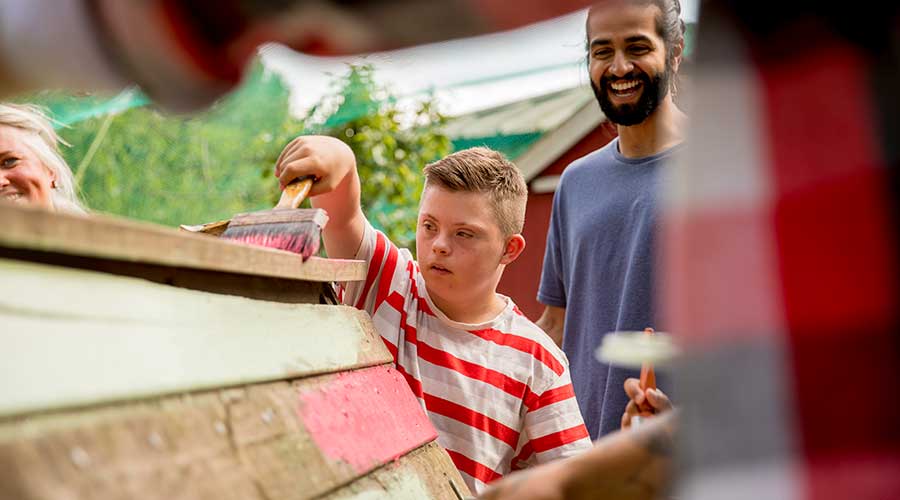Informal guidance issued from the U.S. Department of Education indicates that the requirement in the Individuals with Disabilities Education Act, or IDEA, that students be placed in the “least restrictive environment” extends beyond the confines of the classroom. Below are the questions and answers from the guidance, which is available online at https://www2.ed.gov/policy/speced/guid/idea/memosdcltrs/062212workplacelre2q2012.pdf
Is the individualized education program (IEP) team required to include work placement in a transition-age student’s IEP?
OSEP’s Response: Neither Part B of the IDEA nor its implementing regulations in 34 CFR Part 300 use the term “transition work placements.” Under 34 CFR §300.320(b), beginning not later than the first IEP to be in effect when the child turns 16, or younger if determined appropriate by the IEP Team, and updated annually, thereafter, the IEP must include: (1) appropriate measurable postsecondary goals based upon age appropriate transition assessments related to training, education, employment, and, where appropriate, independent living skills; and (2) the transition services (including courses of study) needed to assist the child in reaching those goals.
As defined in 34 CFR §300.43, transition services are a coordinated set of activities for a child with a disability that: (1) is designed to be within a results-oriented process, that is focused on improving the academic and functional achievement of the child with a disability to facilitate the child’s movement from school to post-school activities, including postsecondary education, vocational education, integrated employment (including supported employment), continuing and adult education, adult services, independent living, or community participation; (2) is based on the individual child’s needs, taking into account the child’s strengths, preferences, and interests; and (3) includes: (a) instruction; (b) related services; (c) community experiences; (d) the development of employment and other post-school adult living objectives; and (e) if appropriate, acquisition of daily living skills and provision of a functional vocational evaluation. Transition services for children with disabilities may be special education if provided as specially designed instruction, or a related service, if required to assist a child with a disability to benefit from special education.
Nothing in the IDEA requires a specific service, placement, or course of study, but leaves such decisions to the IEP Team for the individual child. The IDEA emphasizes the importance of parental involvement and student involvement, when appropriate, in the development of the IEP. As indicated above, transition services are defined broadly and include a range of services, including vocational and career training that are needed to meet the individual needs of a child with a disability. Work placement can be an appropriate transition service, depending on the individual needs of a student, but is not a required component of all IEPs that address transition services. If an IEP team determines that work placement is an appropriate transition service for a child, it must be included in the child’s IEP.
The definition of special education in 34 CFR §300.39 includes vocational education, which is defined as organized educational programs that are directly related to the preparation of individuals for paid or unpaid employment, or for additional preparation for a career not requiring a baccalaureate or advanced degree.
Is the IEP Team required to provide parents with “notice of placement” when determining a student’s work placement?
OSEP’s Response: Under 34 CFR §300.503(a), written notice that meets the requirements of 34 CFR §300.503(b), must be given to the parents of a child with a disability a reasonable time before the public agency proposes or refuses to initiate or change the identification, evaluation, or educational placement of the child, or the provision of a free appropriate public education (FAPE) to the child.
If the work placement is included in a student’s IEP, it becomes part of the student’s educational program and part of the provision of FAPE to the student. If a public agency is proposing or refusing to initiate or change a work placement that is part of a child’s transition services, the public agency would be required to provide the parent with written notice, as described above, a reasonable time before the proposed placement is initiated or changed. Therefore, initiating or changing a child’s work placement that is part of the child’s IEP would require such prior written notice as outlined in 34 CFR §300.503.
Can segregated work be considered an appropriate outcome, particularly with appropriate assessment in a LRE before such a placement occurs?
OSEP’s Response: The LRE requirements are a fundamental provision of Part B of the IDEA. According to the LRE requirements in 34 CFR §§300.114-300.118, each public agency must ensure that (1) to the maximum extent appropriate, children with disabilities, including children in public or private institutions or other care facilities, are educated with children who are nondisabled; and (2) special classes, separate schooling, or other removal of children with disabilities from the regular education environment occurs only if the nature or severity of the disability is such that education in regular classes with the use of supplementary aids and services cannot be achieved satisfactorily. Before a child with a disability can be placed outside the regular educational environment, the group of persons making the placement decision must consider whether supplementary aids and services could be provided that would enable education of the child in the regular educational setting to be achieved satisfactorily. If a determination is made that a particular child with a disability cannot be educated satisfactorily in the regular educational environment, even with the provision of appropriate supplementary aids and services, that child then could be placed in a setting other than the regular educational setting. Placement decisions, including those related to transition services (including work placement), must be based on these LRE principles and made by the IEP Team.
Under 34 CFR §300.320(b), as you point out, the IEP must include appropriate measurable postsecondary goals based upon age appropriate transition assessments related to training, education, employment, and, where appropriate, independent living skills; and the transition services (including courses of study) needed to assist the child in reaching those goals. The specific transition assessments used to determine appropriate measurable postsecondary goals will depend on the individual needs of the child, and are, therefore, best left to States and districts to determine on an individual basis. Therefore, there is no specific requirement that placement in various work environments be part of the assessment process. Under the IDEA, a segregated employment program may be an appropriate work placement for a particular student if determined appropriate by that student’s IEP Team based on the LRE requirements and the specific individualized needs of that student. That is, the IDEA does not prohibit segregated employment, but the LRE provisions would apply equally to the employment portion of the student’s program and placement.
Is the LEA required to provide supplemental aids and services to allow the student to participate in the least restrictive work placement possible?
OSEP’s Response: Supplementary aids and services are defined in 34 CFR §300.42 as aids, services, and other supports that are provided in regular education classes, other education-related settings, and in extracurricular and nonacademic settings, to enable children with disabilities to be educated with nondisabled children to the maximum extent appropriate in accordance with §§300.114-300.116. Under 34 CFR §300.320(a)(4), the IEP for each child with a disability must include a statement of the special education and related services and the supplementary aids and services, based on peer reviewed research to the extent practicable, to be provided to the child, or on behalf of the child, and a statement of the program modifications or supports for school personnel that will be provided to enable the child: (1) to advance appropriately toward attaining the annual goals; (2) to be involved in and make progress in the general education curriculum in accordance with 34 CFR §300.320(a)(l), and to participate in extracurricular or other nonacademic activities; and (3) to be educated and participate with other children with disabilities and nondisabled children in the activities described in this section.
Therefore, when an IEP Team includes a work placement as part of the student’s transition services, the IEP team must consider, and include in the IEP, as appropriate, any supplementary aids and services needed to enable the student to participate with other students with disabilities and nondisabled students in the work placement described in the IEP. The LEA must provide any supplementary aids and services that are identified on the IEP.
How must LRE for work placements be monitored?
OSEP’s Response: Under 34 CFR §300.120, the State educational agency (SEA) must carry out activities to ensure that the LRE requirements in 34 CFR §300.114 are implemented by each public agency. If there is evidence that a public agency makes placements that are inconsistent with 34 CFR §300.114, the SEA must: (1) review the public agency’s justification for its actions; and (2) assist in planning and implementing any necessary corrective action. Additionally, it would be appropriate for States, as part of their use of data in monitoring activities, to review due process complaints (under 34 CFR
§§300.507-300.518), and State complaints (under 34 CFR §§300.151-300.153) to identify potential problems related to secondary transition, including work placements.
Are States required to consider a student’s work placement when they report the number of students participating in regular education?
OSEP’s Response: Under IDEA section 618(a)(l)(A)(ii), States are required to report on the number of children with disabilities participating in regular education. The instructions for the data collection form that OSEP uses to collect this data states that educational time spent in age-appropriate community-based settings that include individuals with and without disabilities, such as college campuses or vocational sites, should be counted as time spent inside the regular classroom. Therefore, time spent in a work placement that that includes individuals with and without disabilities should be counted as time spent inside the regular classroom.


